7 Elements Included in a Roof Replacement Estimate
Shopping around for roof replacement estimates can seem overwhelming. What should it include? What shouldn't be in it? Will it cover everything...
Now that you’ve been through the roof inspection process, you’re probably looking to draw in a few proposals from a few different companies. Maybe you’re trying to compare the quotes that they give you against each other, and how they stack up in terms of price, material, and work proposals.
If you don’t know what you’re looking for, there’s a good chance this document will be difficult to break down, understand, and decide on. What’s even worse is that some less trustworthy contractors may try to get you to sign something on the spot, or not explain things fully in the hopes that you overlook important parts of the document.
To help you avoid that, we’ll walk you through different sections of our own estimate template and explain it the same way we tell the homeowners that we work with every day.
We’ll be talking about these parts of the roofing estimate:
Alright, let's get started!
When reviewing a roofing estimate, it's important to understand the various cost components that make up the overall price. These components include labor costs, material costs, overhead expenses, and the profit margin.
The labor costs are associated with the skill level of the workers who will be installing your new roof, the complexity of the job, and the time required to complete the project. The complexity of the roof affects labor costs because of how it affects the time needed to complete the work, and the skill level of the workers will greatly affect costs, as workers who have been roofing for decades have the ability to charge more for their labor than those who just got in the game.
Meanwhile, material costs will depend on the quality and brand of the materials used, and overhead expenses refer to the costs of running the roofing company, such as insurance, rent, and office supplies.
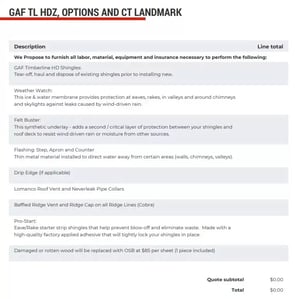
Finally, the profit margin is the amount of money the roofing company intends to make on the project, and this varies depending on the company's overhead expenses and the competition in the market. Some estimates may also include additional costs, such as permit fees or disposal costs for old roofing materials.
In most roofing estimates that you’ll see, the labor and overhead costs will be automatically factored into the line-item materials list, so the amount that you see after all of that is added up should still be the amount that you pay, and there should not be any costs labeled as labor and overhead heaped on top at the end of the project.
In our estimate, we go through the work that we plan to do right at the beginning of it. That way there aren’t any misunderstandings about what will be done as we talk about the materials that will be used for the project.
The proposal should show ways that the company plans to protect your yard, what they will do to complete the work (tear off and install of materials selected) how they’ll clean up, who will be on the job site, and warranty information.
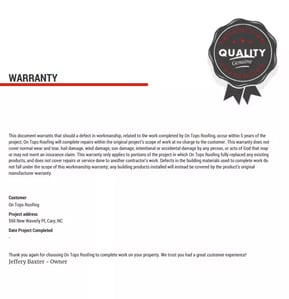
Your contractor should also include sections about what they will and won’t do out of their normal range of work. For example, we have a clause about realigning a satellite, or redoing interior sheet rock for skylight replacements. These are the sorts of things that may need to be done after getting a roof replacement, but are not in the wheelhouse of the roofing contractor.
As far as warranty information goes, there are likely to be a couple of different things to look for, as most products and works will have differing kinds of warranties covering different aspects of the job. For our work, we have listed our 5-10-year workmanship warranty, which covers any potential errors on the part of the contractor, as well as a 50-year warranty against manufacturer’s defects, not including standard wear.
As you’re flipping (or scrolling) through the estimate, you’re gonna run across a lot of materials and terminology that you may not be entirely familiar with.
Hopefully, the contractor has included brief descriptions and images of the different parts of the system to help you understand it, but in case they don’t, here’s a brief overview of the kinds of materials that we would be installing on the roof.
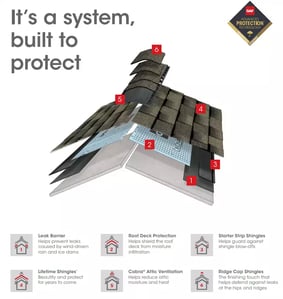
These are all the materials that go into installing a proper, complete roofing system. If your estimate is missing some of them, ask about it! The contractor should be able to explain why your home doesn't need flashing in particular areas, or why they want to use a specific kind of roof vent.
A key section to look for in any proposal, is how and when you’ll be expected to pay for the work. Some contractors may ask for deposits up front, or may charge additional fees for certain methods of payment, like using financing or credit cards. This is a section that should be read carefully, as you don’t want to get surprised with anything in the long run.
Any roofing company worth its salt will have the appropriate licenses and certificates shown prominently in the proposal. If these things aren’t located in it, there’s a solid chance that the company doesn’t have them.
Depending on the state that you live in, contractors may not need to be licensed in their specific area, or to hold a general contractors license if they just want to work. Those that are licensed though have demonstrated their knowledge and ability to complete the work at a high level.
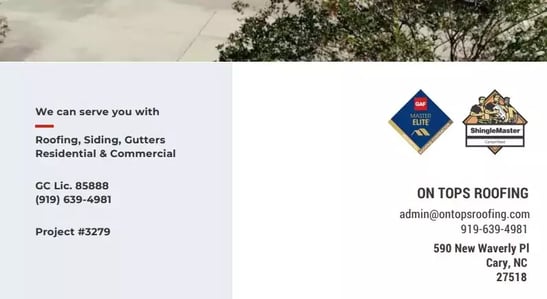
Roofing manufacturers like GAF, CertainTeed, and Owens Corning all have their own certification programs for contractors to show their prestige and status with the company. The rewards for achieving these levels include being able to show the badge in places like the roofing estimate, which helps homeowners know the level of expertise the company has.
We’ve talked about what you should hope to see in your roofing estimate, but what are some things you DON’T want to see?
Check out our blog on Finding a Raleigh Roofing Company to learn about some ways to look for companies, as well as some positive and negative things to pay attention to when looking for them!
On Tops Roofing has been helping the homeowners that we work with in Raleigh, NC read through our estimates for over 30 years. If you need help understanding the work that needs to be done on your roof, we’re on it!

Shopping around for roof replacement estimates can seem overwhelming. What should it include? What shouldn't be in it? Will it cover everything...
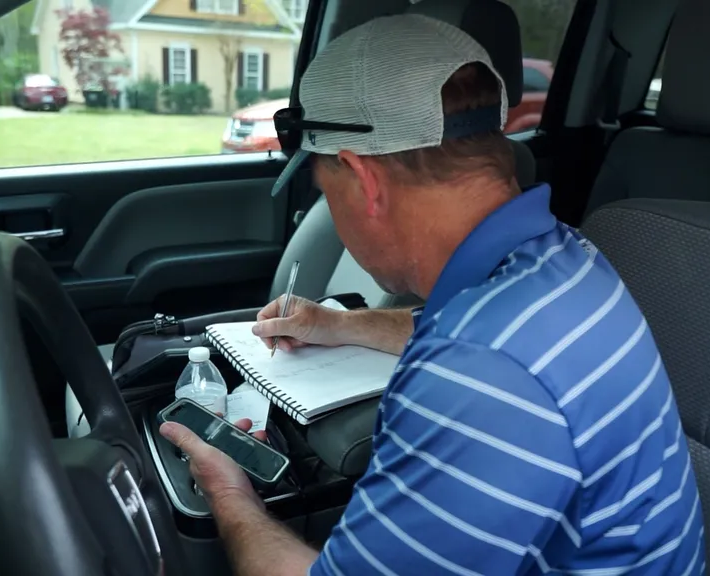
When you first start looking into getting a roof replacement, or start having some issues with your roof, one of the first things you should do is...
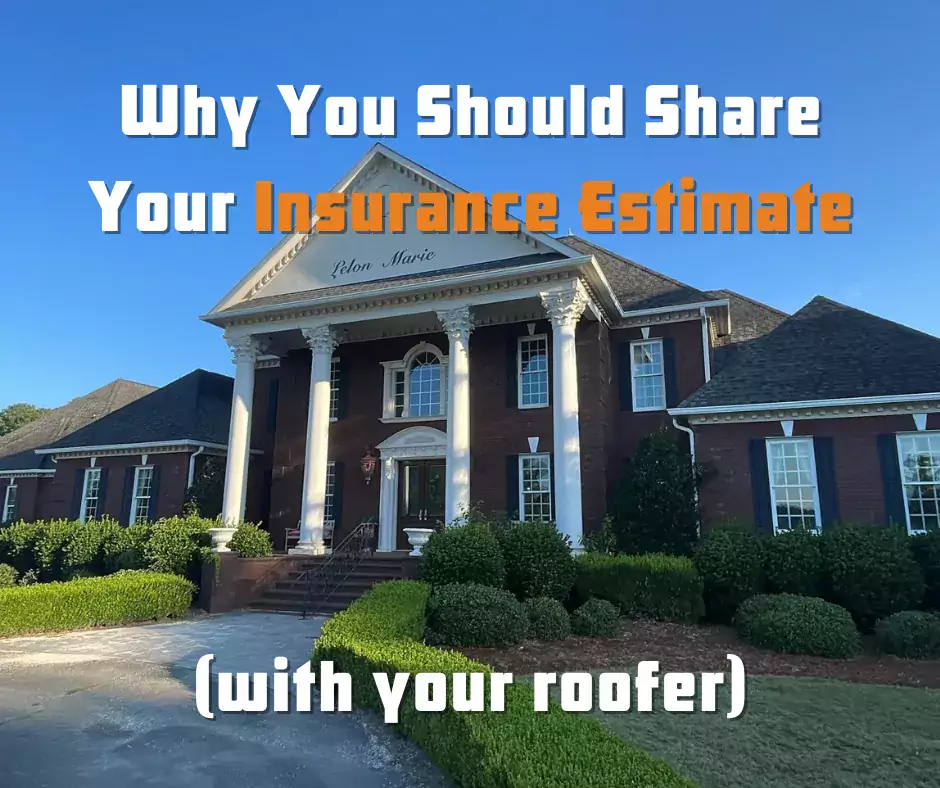
When your roof endures the impact of a severe storm, it's natural to feel concerned about its condition. Fortunately, if you have homeowner's...